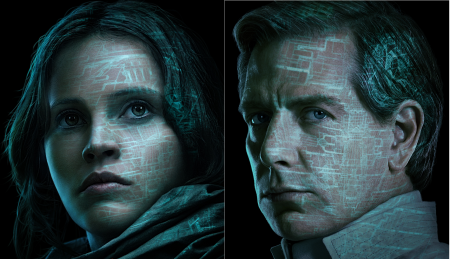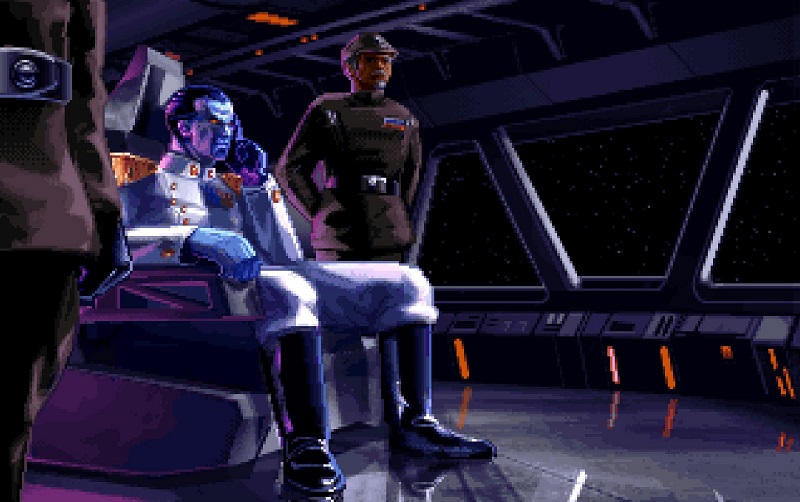–MAJOR ROGUE ONE SPOILERS AHEAD–

Rogue One is a movie about many things, but one of the most obvious things is that it’s a movie about the Death Star plans, the building of the Rebellion, and the start of the Galactic Civil War that we otherwise call the Star Wars original trilogy. The main villain is the architect of the Death Star, the heroine starts as the daughter of the Death Star’s designer and ends the film as the designer of the Rebellion itself. But there’s more to the movie than that. Rogue One, though ostensibly a war film, ends up being a very political film about the people who built the two sides of the war, and the people who fight it.
The actors involved are political, with the Rebellion led by senators and the Empire led by a politician-turned-monarch. Rogue One gives us fascinating glimpses into how both organizations work, and how they were built by people whose conditions, circumstances, and goals end up changing the face of galactic politics. It’s not just a story about war, but it’s a story about politics, and ultimately, how it’s people that shape both.
Let’s start with the Empire. Orson Krennic is a different type of Imperial villain — he’s alternatively described as an apparatchik and a man of science, a man of the working class who’s not of the well-spoken Coruscanti élite we’re used to (but neither is Tarkin, fine accent and manners or not). What are his goals? Well, he wants to build the Death Star and earn the favor of the Emperor. He’s pretty transparent on that end. But it’s more than that – his entire story in this film is political, as his actions are dictated by his rivalries and intrigues with Tarkin and Vader. There’s almost nothing military about his objectives at all, beyond the surface-level needs to secure the Death Star plans. Yet the conflicts that he, Tarkin, and Vader create in jockeying for power create the circumstances for the galaxy to blaze into warfare.
As for the Rebellion? Goodness, they’ve just formed and already they are fracturing at the seams. Not only are there profound disagreements as to how – or even whether – to engage the Empire, but there are schemes within schemes inside the Alliance command structure. Everyone is convinced that they have to do what’s necessary to save the Alliance, even if it means misleading the other leaders and even if it means doing terrible things. The Alliance is much more like the Empire than it’s willing to admit, as Jyn points out. On the micro scale, the Rogue One crew are as riven by disagreements and as attached to their pasts as the rest of the Alliance – but they find a common purpose.
![Star_Wars_Propaganda_New_Cover[1]](http://eleven-thirtyeight.com/wp-content/uploads/2016/10/Star_Wars_Propaganda_New_Cover1-337x450.jpg) (Programming note: this piece is the first of three about Star Wars Propaganda. On Friday and next Monday, I’ll be posting a two-part interview with the author, Pablo Hidalgo.)
(Programming note: this piece is the first of three about Star Wars Propaganda. On Friday and next Monday, I’ll be posting a two-part interview with the author, Pablo Hidalgo.)![9781484705667[1]](http://eleven-thirtyeight.com/wp-content/uploads/2016/10/97814847056671-298x450.jpg) The chatter around Ahsoka has been very interesting, and expectations are high for a novel about a popular character who exited two TV series with fans clamoring for more. We’ve seen folks wonder if the novel will bridge the whole 15 years between The Clone Wars and Star Wars Rebels, or whether the novel will address issues like Ahsoka’s romantic inclinations or position on the Force’s duality (or lack thereof). Folks have wondered whether the novel would revive yet-to-be-made episode arcs from the cancelled TCW. We’ve even seen people wondering if Ahsoka will have something for readers uninterested in Ahsoka as a character. These are interesting questions and interesting expectations, but they’re to be expected when the star of the novel is no less a figure than the apprentice of Anakin Skywalker and a survivor of a galaxy-shattering conflict. Folks might come to expect a story on as large a canvas as The Clone Wars, with stakes just as high. That’s what the character Ahsoka deserves, right?
The chatter around Ahsoka has been very interesting, and expectations are high for a novel about a popular character who exited two TV series with fans clamoring for more. We’ve seen folks wonder if the novel will bridge the whole 15 years between The Clone Wars and Star Wars Rebels, or whether the novel will address issues like Ahsoka’s romantic inclinations or position on the Force’s duality (or lack thereof). Folks have wondered whether the novel would revive yet-to-be-made episode arcs from the cancelled TCW. We’ve even seen people wondering if Ahsoka will have something for readers uninterested in Ahsoka as a character. These are interesting questions and interesting expectations, but they’re to be expected when the star of the novel is no less a figure than the apprentice of Anakin Skywalker and a survivor of a galaxy-shattering conflict. Folks might come to expect a story on as large a canvas as The Clone Wars, with stakes just as high. That’s what the character Ahsoka deserves, right?
 We’re so excited to write about Life Debt that we’re doing so on our phone, since we’re currently away from our computer for a couple weeks. Oh and fair warning, there will be spoilers after the cut – we won’t spoil the end or plot beats, but we will discuss characters.
We’re so excited to write about Life Debt that we’re doing so on our phone, since we’re currently away from our computer for a couple weeks. Oh and fair warning, there will be spoilers after the cut – we won’t spoil the end or plot beats, but we will discuss characters.